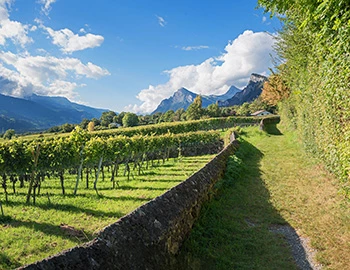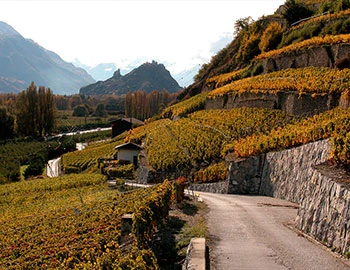Pinot Blanc 2022
AOC Graubünden, Hansruedi Adank, 750 ml

| Grape variety: | Pinot blanc |
| Producer: | Hansruedi Adank |
| Origin: | Switzerland / Ostschweiz / Graubünden |
Description
Discreet, fresh aroma reminiscent of citrus fruits, pineapple and green-yellow reneclaud. On the palate it presents itself yellow-fruity, mineral and elegant. The crisp and juicy acidity makes this Bündner Weissburgunder a wonderful drinking experience.
Attributes
| Origin: | Switzerland / Ostschweiz / Graubünden |
| Grape variety: | Pinot blanc |
| Label: | Vegan |
| Ripening potential: | 1 to 5 years |
| Drinking temperature: | 10 to 14 °C |
| Food Pairing: | Asparagus specialities, Crispy roast chicken, Apéro riche, Salad with vegetables, pulses, pasta |
| Vinification: | fermentation in steel tank, long must fermentation, fermentation at low temperatures |
| Harvest: | hand-picking |
| Maturation: | partly in steel tank, short cultivation |
| Bottling: | filtration |
| Volume: | 13.0 % |
| Note: | Contains sulphites |
Pinot blanc
Lively sparkling, substantial white
The Pinot blanc has the same genetic fingerprint as Pinot gris and Pinot noir. They only differ in colour. The mutation from red to white was noted over a century ago in Burgundy. Suddenly, berries of differing colorations were hanging on the same stock. The bouquet of the Pinot blanc is fresh and floral with notes of citrus, apple, pear and apricot. In Alsace, it yields fragrant sparkling wines; it also enters into some champagnes. Vintners in Germany and Austria produce an abundance of Pinot blanc with a good deal of substance, blending and backbone. Representatives from Switzerland demonstrate a similar profile. There, the Pinot blanc grows mainly in Valais, Vaud and in Grisons.

Graubünden
Graubünden: Mecca for Burgundy varieties
Nowhere in Switzerland has a better ratio of first-class Pinot noir crops to cultivation area than Graubünden. The ageing philosophy of vintners here leaves its imprint even more than the subtle differences in terroir from one vineyard village to the next. In recent years, three Pinot types have established themselves here: the light and sweet Herrschäftler for everyday drinking, the selections aged in large wooden barrels or used barriques, and of course the premium selections of individual estates matured in barriques.

Ostschweiz
Eastern Switzerland: an intriguing puzzle
Eastern Switzerland has long been positioned on the northern rim of the climate zone where the cultivation of popular Swiss varieties is possible. Due to a warming climate, the vineyards of Aargau, Zurich, Schaffhausen, Thurgau and Graubünden are now in the zone where varieties such as Müller-Thurgau or Pinot Noir succeed excellently. But even long-established, almost-forgotten varieties such as Elbling, Räuschling and Completer are experiencing a renaissance.

Switzerland
Switzerland – A small country with enormous diversity
Switzerland is famous for its banks, watches, and cheese, but not necessarily for its wine. The Swiss didn't invent wine, but they have been extremely open and curious to it. Wine culture arrived in what is now modern Switzerland via several routes: from Marseilles to Lake Geneva and the Lower Valais region; from the Aosta Valley through the Great St. Bernard Pass to the rest of Valais; from the Rhone through Burgundy, across the Jura Mountains to Lake Constance; and from Lombardy to Ticino, and then on to Grisons.



